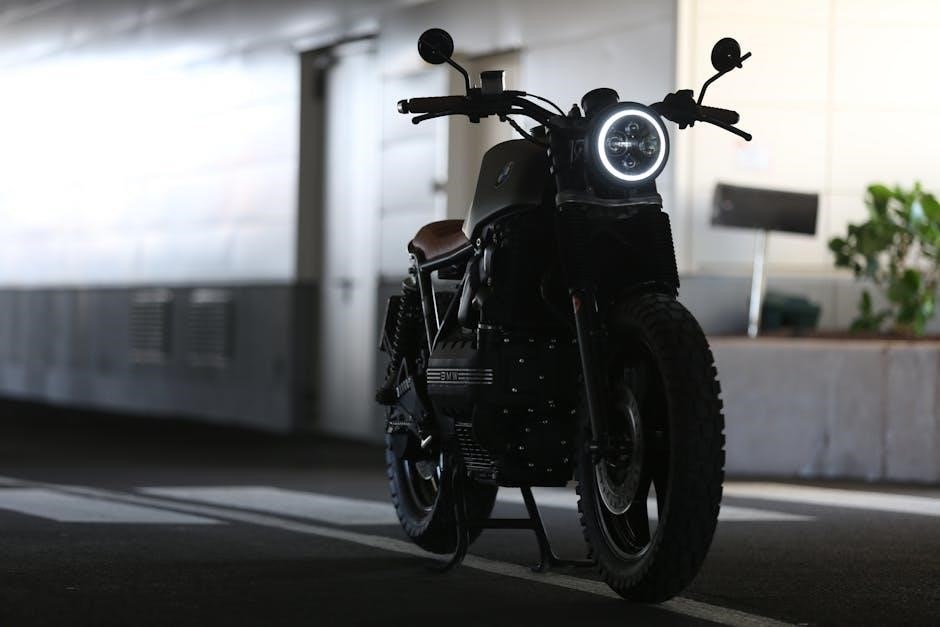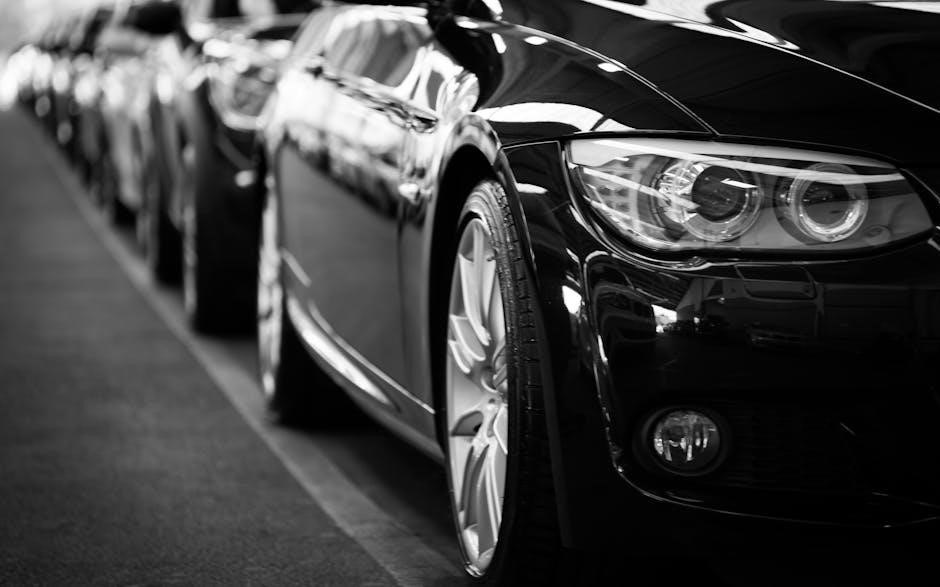The BMW E38 is a flagship luxury sedan produced from 1994 to 2001‚ renowned for its balance of opulence‚ performance‚ and timeless design. Whether you’re a seasoned enthusiast or a first-time buyer‚ this guide provides essential insights into model variations‚ common issues‚ and maintenance tips‚ helping you make an informed decision and avoid costly surprises.
Why Consider the BMW E38?
The BMW E38 is a timeless luxury sedan that combines opulent comfort‚ robust performance‚ and timeless design. With a range of powerful engine options and advanced features for its era‚ it represents a blend of classic elegance and modern engineering. Its reputation for reliability and durability‚ especially when properly maintained‚ makes it a high-value purchase for enthusiasts and collectors. The E38 also boasts a dedicated community and manageable maintenance costs‚ making it a rewarding choice for those seeking a premium driving experience.
A Brief History of the BMW E38
The BMW E38‚ produced from 1994 to 2001‚ represents a pinnacle in BMW’s 7 Series lineage. It debuted as a successor to the E32‚ offering refined styling‚ enhanced performance‚ and cutting-edge technology. Available with various engine options‚ including V8 and V12 configurations‚ the E38 was praised for its driving dynamics and luxurious interior. Over its production run‚ it underwent subtle updates‚ with a facelift in 1999 introducing new features and styling tweaks‚ solidifying its legacy as a classic in BMW’s history.

Understanding Model Variations
The BMW E38 was produced from 1994 to 2001‚ offering a range of models with varying engine options. The lineup included the 728i‚ 730i‚ 735i‚ 740i‚ and 750i‚ each providing a unique balance of performance and luxury.
Standard Models: 728i‚ 730i‚ 735i‚ 740i‚ 750i
The BMW E38 series offers a range of standard models‚ each tailored to different driver preferences. The 728i features a 2.8L inline-6 engine‚ offering a balance of efficiency and performance. The 730i‚ 735i‚ and 740i models provide increasing power with larger engines‚ while the 750i boasts a powerful 5.4L V12‚ delivering exceptional luxury and acceleration. Each model offers unique characteristics‚ ensuring there’s an E38 to suit every buyer’s needs‚ from fuel efficiency to raw power.
Special Editions and Unique Trim Levels
The BMW E38 was offered in several special editions and unique trim levels‚ enhancing its appeal. The Individual and Highline models featured exclusive interior designs‚ premium materials‚ and bespoke options. Limited-production models like the 740i Individual and 750i Highline boasted upgraded features such as heated seats‚ wood trim‚ and advanced electronics. These special editions catered to discerning buyers seeking a more personalized luxury experience‚ making them highly sought after by collectors and enthusiasts today.
Key Differences Between Model Years
The BMW E38 underwent notable updates throughout its production run. Early models (1994-1998) featured classic styling‚ while the 1999 facelift introduced updated headlights‚ bumpers‚ and interior trim. Later models (1999-2001) saw improvements in technology‚ including enhanced navigation systems and refined engine management. These changes make the facelift models more desirable‚ as they combine timeless aesthetics with modernized features. Understanding these differences helps buyers choose the best model year for their preferences and budget;
Evaluating the Car’s History
Evaluating the car’s history involves checking maintenance records‚ accident history‚ and previous owners. Look for rust and bodywork issues‚ as these can indicate poor upkeep or hidden damage.
Importance of Maintenance Records
Maintenance records are crucial for understanding a BMW E38’s condition and history. They reveal if the car has been serviced regularly‚ with issues addressed promptly. Look for consistent servicing schedules‚ repair invoices‚ and evidence of preventative maintenance. A well-documented history indicates a caring owner‚ reducing the risk of hidden problems like cooling system failures or VANOS issues. Always request these records to ensure transparency and avoid costly surprises down the road.
Checking for Accident History and Previous Owners
Verifying the accident history and previous ownership of a BMW E38 is vital to assess its value and reliability. Use services like Carfax or AutoCheck to uncover any collisions or major repairs. A clean history suggests minimal wear‚ while multiple owners may indicate potential neglect. Ensure the vehicle’s VIN matches all records to avoid fraud. This step helps buyers make informed decisions and avoid purchasing a car with hidden damage or unresolved issues.
Identifying Rust and Bodywork Issues
Rust and bodywork problems can significantly impact the BMW E38’s value and longevity. Inspect the trunk‚ doors‚ and suspension components for signs of rust‚ as these areas are prone to moisture accumulation. Paint bubbling or flaking indicates underlying corrosion. Check for previous repairs or filler‚ which may mask deeper issues. Addressing rust early can prevent costly damage‚ but severe cases may warrant avoiding the vehicle altogether. A thorough inspection is essential to ensure the car’s structural integrity remains intact.

Inspecting the Vehicle
A thorough inspection of the BMW E38 focuses on key areas like the engine‚ transmission‚ and electrical systems. Look for signs of wear‚ rust‚ or previous repairs‚ and ensure all components function as intended. Pay special attention to the trunk‚ doors‚ and suspension‚ as these areas are prone to moisture and potential issues. A detailed examination can reveal hidden problems‚ ensuring a well-informed purchase decision.
Common Wear and Tear Patterns
The BMW E38 often shows wear on suspension components‚ particularly the front subframe and control arms‚ which can cause the infamous “shimmy” vibration. Rust commonly appears in the trunk floor‚ door sills‚ and suspension mounts. Additionally‚ the cooling system may leak due to aging hoses or cracked radiators. The VANOS system can also fail‚ leading to reduced performance. Electrical issues may arise from worn wiring or faulty sensors. Inspecting these areas thoroughly is crucial for a reliable purchase.
Key Areas to Inspect: Engine‚ Transmission‚ Suspension
Examine the engine for oil leaks‚ particularly around the valve cover gasket and head gasket. Check the transmission for smooth shifting and signs of fluid degradation. Inspect the suspension for worn bushings and ball joints‚ which can cause alignment issues. Look for rust on suspension components and subframe mounts‚ as these are prone to corrosion. Ensure the cooling system is leak-free to prevent overheating. A thorough inspection of these areas ensures reliability and avoids costly repairs down the road.
Electrical and Electronic Systems: What to Look For
Inspect the DSC (Dynamic Stability Control) system for faults‚ as malfunctions can affect stability. Check the VANOS system for wear‚ which may cause engine performance issues. Test all electronic features‚ including the ABS and ASC systems‚ to ensure proper function. Look for failing wheel speed sensors‚ which can disable safety systems. Inspect the body control module for faults‚ as it controls many electrical functions. A thorough inspection of these systems is crucial to avoid costly repairs and ensure reliability.
Common Problems to Be Aware Of
The BMW E38 is generally reliable but has specific issues to watch for‚ such as the “dreaded shimmy” in the suspension‚ cooling system failures‚ and electronic malfunctions like VANOS and DSC problems. These issues can be costly if not addressed early‚ so thorough inspections and maintenance records are essential for a smooth ownership experience.
The Dreaded Shimmy and Suspension Issues
The “dreaded shimmy” is a well-documented issue in the BMW E38‚ characterized by a vibration felt through the steering wheel‚ often at higher speeds. This problem is typically caused by misaligned or worn suspension components‚ such as ball joints‚ control arms‚ or bushings. Additionally‚ unbalanced wheels or faulty tire rod ends can exacerbate the issue. Addressing this problem early is crucial‚ as it can lead to further damage and increased repair costs. A thorough inspection of the suspension system is highly recommended before purchase.
Cooling System Failures and Solutions
The BMW E38’s cooling system is prone to failures‚ particularly in the radiator‚ water pump‚ and hoses‚ which can lead to overheating and costly engine damage. Regular inspections of hoses‚ belts‚ and connectors are essential. Replacing the radiator and water pump proactively‚ especially around the 80‚000-mile mark‚ can prevent sudden failures. Upgrading to an aluminum radiator and using high-quality coolant are recommended solutions to enhance reliability and avoid breakdowns. Addressing these issues promptly ensures optimal performance and longevity of the vehicle.
Electronic Gremlins: VANOS‚ DSC‚ and More
The BMW E38’s advanced electronics can be a source of frustration‚ with issues like VANOS (Variable Nockenwellen Steuerung) and DSC (Dynamic Stability Control) systems commonly causing problems. VANOS failures often result from worn components or oil degradation‚ leading to reduced performance and rough engine operation. DSC issues may stem from faulty sensors or software glitches‚ affecting stability and traction control. Regular diagnostic checks and maintaining the electrical systems are crucial to prevent these gremlins from disrupting your driving experience. Early intervention can save you from costly repairs down the road.

Evaluating the Cost of Ownership
- Initial Purchase Price: Lower for older models‚ but factor in condition and mileage.
- Maintenance Costs: Higher due to specialized parts and labor for luxury vehicles.
- Repair Expenses: Potential for costly fixes‚ especially for electronic and mechanical systems.
- Fuel Efficiency: Varies by engine‚ with V8 and V12 models being less economical.
- Insurance: Premiums may be higher for luxury and older vehicles.
Initial Purchase Price vs. Long-Term Costs
The BMW E38’s initial purchase price can be relatively affordable‚ especially for older models‚ but it’s crucial to balance this with long-term costs. Lower-priced cars may have higher mileage or hidden issues‚ leading to expensive repairs. While the upfront cost might seem attractive‚ factor in maintenance‚ parts replacement‚ and potential system overhauls. Budgeting for these expenses is essential to avoid financial surprises down the road. Prioritizing a well-maintained vehicle can help mitigate long-term costs.
Estimated Maintenance and Repair Costs
Maintenance and repair costs for the BMW E38 can vary significantly depending on the vehicle’s condition and mileage. Common repairs‚ such as cooling system overhauls or addressing the “shimmy” issue‚ can range from $500 to $2‚000. Parts for older models may be expensive‚ but many components are still available. Regular maintenance‚ such as oil changes and inspections‚ is crucial to prevent costly breakdowns. Budgeting $1‚000 to $2‚000 annually for upkeep is a reasonable estimate to keep your E38 running smoothly.
Fuel Efficiency and Running Costs
Fuel Efficiency and Running Costs
Fuel efficiency for the BMW E38 varies by engine‚ with the 728i being the most economical‚ while V8 and V12 models consume more fuel. Expect around 15-25 mpg combined‚ depending on driving conditions and maintenance. Running costs include higher insurance premiums and potential repair expenses for aging systems. Budgeting for fuel‚ insurance‚ and occasional repairs is essential to enjoy ownership of this classic luxury sedan without financial strain.
Negotiation and Purchase Tips
Assess the car’s condition‚ review maintenance records‚ and use identified issues as bargaining points. Compare market prices‚ and consider a pre-purchase inspection to negotiate fairly.
How to Negotiate the Best Price
Research the market value of the specific E38 model and year to establish a fair price range. Highlight any needed repairs or issues found during inspection to negotiate reductions. Emphasize the cost of addressing common problems like the “dreaded shimmy” or cooling system failures. Consider requesting maintenance records to verify the car’s condition. A pre-purchase inspection report can also strengthen your bargaining position. Be prepared to walk away if the deal doesn’t meet your expectations.
What to Ask the Seller
Ask the seller about the car’s maintenance history‚ including records of repairs for common issues like the “dreaded shimmy” or cooling system failures. Inquire about the condition of expensive components such as the transmission‚ VANOS system‚ and engine. Request details about any accidents‚ previous owners‚ or rust repairs. Find out if the car has been stored properly or used as a daily driver. Lastly‚ ask why they are selling to understand their motivation and potential hidden issues.
Test Drive Checklist
During the test drive‚ check for smooth acceleration and any unusual vibrations‚ especially at higher speeds‚ which could indicate suspension or drivetrain issues. Test all electronic features‚ including climate control‚ navigation‚ and adaptive cruise control‚ to ensure they function properly. Listen for any unusual noises from the engine‚ transmission‚ or brakes. Evaluate the steering for responsiveness and alignment. Also‚ monitor the temperature gauge to detect potential cooling system problems during operation.

Post-Purchase Steps
After purchasing your BMW E38‚ prioritize a thorough inspection and address any immediate maintenance needs. Schedule repairs for known issues like the cooling system or suspension. Consider upgrading components like brakes or electronics for improved performance and reliability. Joining the BMW E38 community can provide valuable resources‚ advice‚ and support to ensure your car remains in top condition and retains its value over time.
Initial Maintenance and Repairs
After purchasing your BMW E38‚ prioritize addressing known issues like cooling system leaks‚ suspension problems‚ and VANOS system malfunctions. Replace worn components such as brake pads‚ belts‚ and hoses. Check for rust and ensure all electrical systems are functioning properly. Consulting a specialist can help identify hidden issues early. Perform a thorough inspection of the engine‚ transmission‚ and suspension to prevent costly repairs down the line. Addressing these areas initially ensures reliability and preserves the car’s value.
Upgrades and Modifications
Upgrading your BMW E38 can enhance performance‚ comfort‚ and aesthetics. Popular modifications include engine tuning‚ performance exhaust systems‚ and suspension upgrades for improved handling. Interior enhancements like modern infotainment systems or bespoke trim options can elevate the luxury experience. Consider lightweight alloy wheels and aerodynamic body kits for a sportier look. Always ensure modifications align with the car’s classic character and consult the E38 community for proven upgrades that maintain reliability and authenticity.
Joining the BMW E38 Community
Engaging with the BMW E38 community offers invaluable resources and support for owners and enthusiasts. Forums like Bimmerforums and specialized Facebook groups provide technical advice‚ maintenance tips‚ and shared experiences. Local BMW clubs and meets allow owners to connect‚ showcase their cars‚ and learn from others. Participating in these communities can enhance your ownership experience‚ offering insights into upgrades‚ troubleshooting‚ and preserving your E38’s legacy. Active engagement ensures you stay informed and inspired by fellow enthusiasts.
The BMW E38 remains a timeless symbol of luxury and performance‚ offering exceptional value for enthusiasts. This guide equips buyers with the knowledge to make informed decisions‚ ensuring a rewarding ownership experience.
Final Thoughts on Buying a BMW E38
Purchasing a BMW E38 can be a rewarding experience‚ offering a blend of luxury‚ performance‚ and classic styling. While common issues like the “dreaded shimmy” and cooling system failures exist‚ thorough research and inspections can mitigate risks. Buyers should prioritize well-maintained models‚ review service history‚ and budget for potential repairs. With careful consideration‚ the E38 can provide years of enjoyable ownership and driving satisfaction‚ making it a worthwhile investment for enthusiasts.
Is the BMW E38 Worth It?
The BMW E38 is a timeless luxury sedan that offers a unique blend of performance‚ comfort‚ and elegance. Despite common issues like suspension problems and cooling system failures‚ its enduring appeal and relatively low purchase cost make it a compelling choice for enthusiasts. With proper maintenance and awareness of potential repairs‚ the E38 can be a rewarding and enjoyable classic vehicle for those who appreciate its heritage and driving dynamics.
